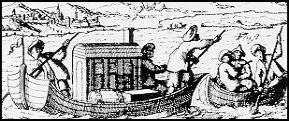| From the Mountains to the Sea |
| Some exiled Salzburger salt miners, mostly from Dürrnberg and Berchtesgaden, went to Holland. Firmian had not allowed some miners to leave with the others, but in 1732, Dürrnberg miner Tobias Woerndl made secret inquiries as to which nation would be willing to take in extra exiles. He returned with favorable letters from Holland. The area of today's West Zeeuws Vlaanderen had lost many inhabitants because of a bad economy and had an urgent need for new farm workers. Firmian and his chancellor determined the emigration day as November 29, 1732. The Dutch envoy Baron von Gallieris promised the Salzburgers admission into the Netherlands under generous terms. They would immediately receive Dutch nationality and be deemed equal to the native population in all things. A small group of 59 Salzburgers had already been attracted to Holland under a strict criteria that allowed only families and no people over 45 years old or those who were young, independent and single. This group of Salzburgers formed a small minority on the island Walcheren. Their names were quickly lost and they assimilated within thirty years. See: 1732 file below for names The Dutch would pay all travel expenses for the Dürrnberger group, including food. In Holland they would have free worship, and teachers and ministers at public expenses in their own language. Furnishings, clothing and food were to be free of charge until they could earn a living on their own. On the morning of November 30, 1732, 780 Duerrnberger and 37 Berchtesgadener who had left without permission boarded three ships at Hallein and on December 14th they landed at Regensburg. From there they had to make the rest of the journey on foot to Nürnberg. Here they were allowed rest for a week. They arrived at Kitzingen on the Main January 24, and from there the journey was continued in 8 ships. When they arrived in Ruesselsheim, many of the emigrants became ill and they had to bury four children. They had to stay until February 8th because of bad weather. Storm after storm forced them back to land until February 21, when they arrived at Dutch "Nymwegen" where again they rested for a week before continuing their travel on 18 sailing boats. Now, death took 13 adults and they watched three ships sink in horrible weather. Finally, on March 9, 1733 after four grueling months, they safely landed on the island Cadzand. However, they were forced to locate all over the island even though they had been promised they would remain together. Dissatisfaction of the newcomers arose because many were housed in decrepit houses and stables where Flemish migrants had lived in the summer months. Many were immediately forced to provide for their own maintenance, in contradiction of their agreements. Their separation and dispersion caused language problems, as did the fact that so many Salzburgers were miners and craftsmen, of which there was no need, and not farm workers. The local residents were therefore disappointed there were too many children and old people among the immigrants unable to perform farmer work. "Swamp fever" killed another hundred and many left in November of 1733, the devastated Berchtesgadeners for Nürnberg and the rest leaving mostly for Frankfort am Main. By the end of December, only 42 families with 224 people remained. Under the guidance of their preacher, Johann Gottlob Fischer, these remaining Salzburgers founded a Lutheran municipality in Groede on March 7,1734. The Amsterdam Church Council made it possible for the newcomers to buy farmland and a house. In January, 1735, the Church Council bought a house in Groede that could be used as a house church for the immigrants. The new church was inaugurated on September 1,1743. Meanwhile, the Council had established a fund for permanent support of the immigrant municipality, the Cadzand Fund, and it existed from 1739 up to 1963. The very small group which decided to remain assimilated rapidly. They remained faithful to the Lutheran church, but their names changed, and within two or three generations, their language, a variation of the Salzburg dialect, disappeared as well. Many of the disillusioned Holland group later returned to Germany by the way they had come, and many were recorded in Frankfurt(names on right). Some went on to settle elsewhere. A few went on to the USA: Maurer, Biltz, Crainwetter, Bach, Lackner, Oberdorfer, Saddler and Winter are among some names found in Ebenezer, Georgia records. |

| PDF Files Salzburger Names in Holland You need Adobe |
Their small stone Church in Groede
is still standing. Groede, old and new
is still standing. Groede, old and new
Angerer
Becher
Beinhöfner
Blaßnitz
Bosch
Brandner
Brunner/Prünner
Brunner
Carl
Cranzbiller/Kranzbühler
Creutzaller
Dantze
Dürsch/Dörsch/Dirst
Eckel/Eggl
Ecker
Fenninger
Fischer
Fuchs
Geschwandner
Gruber
Hädl
Hahl
Haller
Hamel
Härle
Heyl
Hochbiller/Hochbüchler
Becher
Beinhöfner
Blaßnitz
Bosch
Brandner
Brunner/Prünner
Brunner
Carl
Cranzbiller/Kranzbühler
Creutzaller
Dantze
Dürsch/Dörsch/Dirst
Eckel/Eggl
Ecker
Fenninger
Fischer
Fuchs
Geschwandner
Gruber
Hädl
Hahl
Haller
Hamel
Härle
Heyl
Hochbiller/Hochbüchler
Kämel / Kehmel / Kambel
Kames
Kamm
Kein / Keyn / Keim
Knecht
Kochl
Kurtz
Landauer
Lechner / Lerchner / Löchner
Lechner
Lentz
Ludwig
Oberbieler
Offner
Pfnür
Raff
Raspe
Renott
Reuter
Rössel
Rothknecht /Rodtknecht /
Rockne
Schneidmann
Steiner
Stocker
Wain
Weserich
Winnisfelder
Kames
Kamm
Kein / Keyn / Keim
Knecht
Kochl
Kurtz
Landauer
Lechner / Lerchner / Löchner
Lechner
Lentz
Ludwig
Oberbieler
Offner
Pfnür
Raff
Raspe
Renott
Reuter
Rössel
Rothknecht /Rodtknecht /
Rockne
Schneidmann
Steiner
Stocker
Wain
Weserich
Winnisfelder
Thanks to Joost Cranberg
| THE SALZBURG EXILE: HOLLAND |
Recommended reading
de Kaste-Mather, E. J. "De ronde
zeeuw-afstammeling van Spanjaard,
Fransman en Salzburger?"
de Kaste-Mather, E. J. "De ronde
zeeuw-afstammeling van Spanjaard,
Fransman en Salzburger?"